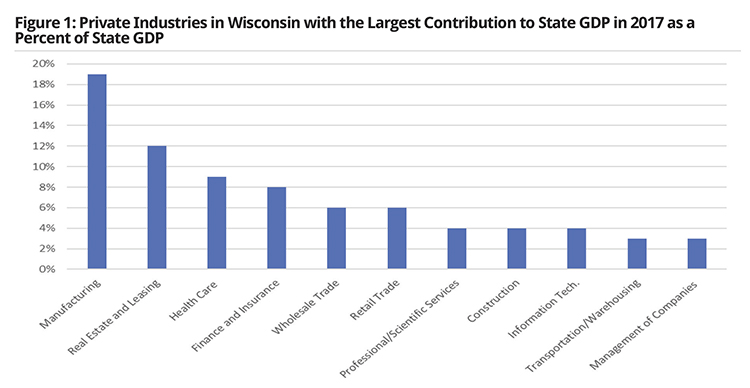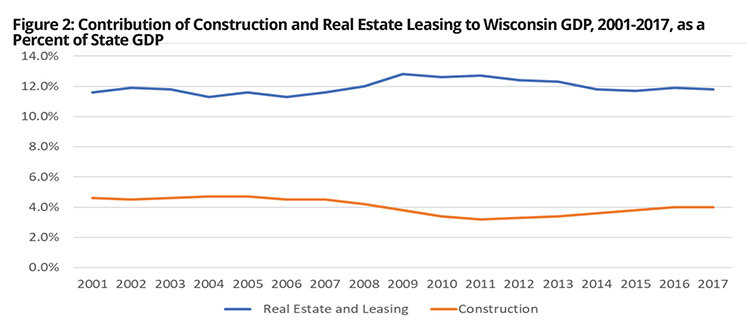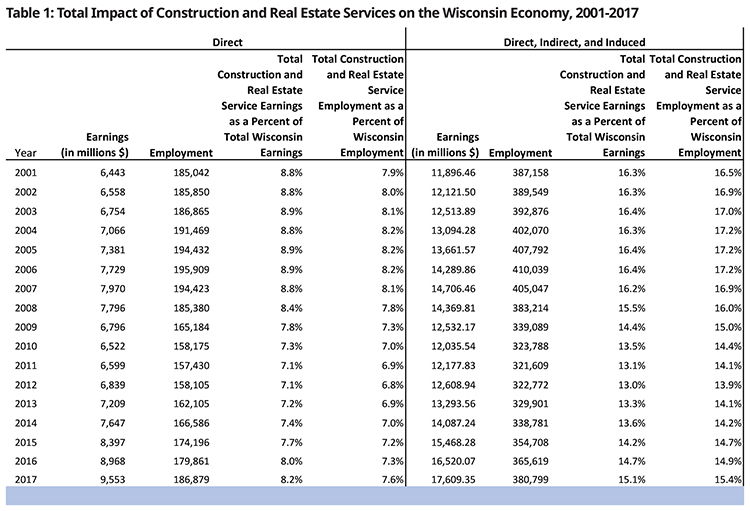If asked to name the most important industries to Wisconsin, most people would likely identify manufacturing, agriculture and tourism, with health care and insurance rounding out the top five. However, according to new study by Professor Mark Eppli, director of the James A . Graaskamp Center for Real Estate at the University of Wisconsin-Madison, the real estate industry is the second-biggest contributor to Wisconsin’s economy.
Real estate’s contribution to Wisconsin’s gross domestic product (GDP)
According to the Eppli study, the real estate industry, when combining both real estate services and construction, generates approximately 15.8 percent of the state’s GDP. This percentage is second only to the manufacturing industry, which contributes approximately 19 percent to the state’s GDP. The remaining industries in the top five include health care with approximately a 9 percent GDP contribution; finance and insurance with approximately 8 percent; and wholesale trade with approximately 6 percent. Individually, real estate and leasing services contribute 11.8 percent to the state’s GDP while construction contributes 4 percent. See Figure 1 below.
According to the study, real estate services includes those services provided by people who are primarily engaged in the selling, buying and renting/leasing of real estate for others; the maintenance of the interior and exterior of buildings; lending and financing of real estate; the transfer of title and other real estate closing services; locksmiths; and septic tank maintenance and service. Real estate construction services include services provided by people who are involved in the construction and renovation of single-family and multifamily residential buildings; construction of commercial and other nonresidential buildings; surveyors; excavators; architects; engineers; interior designers; environmental consultants; and remediation specialists.
Although the real estate industry plays a critical role to Wisconsin’s economy, the overall earnings generated by the real estate industry have been relatively stable over the years but have declined since 2010 due to lagging construction numbers. Specifically, from 2001-2017, real estate and leasing have consistently produced approximately 12 percent of the GDP, while construction GDP fell from approximately 4.7 percent from 2001 to 2017, then fell to roughly 4.0 percent in 2017, which is a 15 percent decline. See Figure 2 on page 26.

Data secured from the Bureau of Economic Analysis.
Real estate’s impact on Wisconsin’s employment and personal earning
Another way to measure an industry’s impact on a state’s economy is by looking at the number of people employed and the personal earnings within the industry. The Eppli study looked at both the direct impact alone as well as a combination of the direct, indirect and induced impact of the industry. The direct impact measures the people who work in the real estate industry and their earnings. Indirect impacts are best thought of as “ripple effects” of the real estate industry onto other secondary industries, such as when the purchase of new carpeting for a home generates income and creates jobs for the carpet sector. Induced impacts result from the retail spending of the direct and indirect industry earnings.
According to the study, the direct impact of the real estate industry on employment in Wisconsin is significant, with over $9.5 billion in personal earning and 186,000 jobs, which equals approximately 8 percent of personal earnings and employment in the state. However, when combining the direct, indirect and induced impact of the real estate industry, the numbers almost double, with more than $17.6 billion in personal earnings and over 380,000 employees. This makes up approximately 15.1 percent of personal earnings and 15.4 percent of employment. See Table 1 on the next page.
Conclusion
In summary, the real estate industry’s role in Wisconsin’s economy is major. The industry contributes 15.8 percent of the state’s GDP, employs 380,000 people, and produces almost $18 billion in personal earnings. Moreover, the personal earnings and employment generated by the real estate industry is 15 to 16 percent of the state’s overall totals. These numbers are likely to increase when new single-family residential development fully recovers from the downturn resulting from the Great Recession.
The results of this study should serve as a powerful tool to better educate state and local officials about the importance of the real estate industry to Wisconsin’s overall economy. Restrictive land-use policies that discourage real estate development not only limit growth in the real estate industry, but also the overall economy. Accordingly, this study should be used to encourage lawmakers to enact public policies and regulations that help rather than harm the industry.
Tom Larson is Senior Vice President of Legal and Public Affairs for the WRA.

Data secured from the Bureau of Economic Analysis.

Table 1 represents industry codes from the North American Industry Classification System, data from the Bureau of Labor Statistics, and the appropriate personal earnings and multipliers from the Bureau of Economic Analysis.